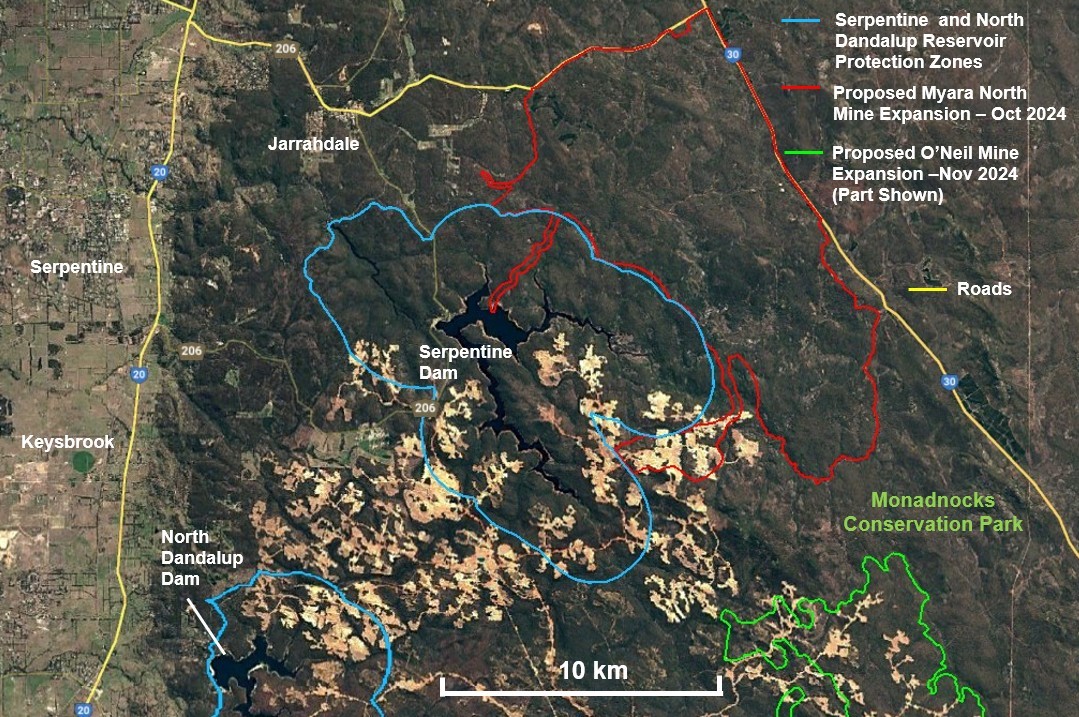Water Contamination
Bauxite mining presents a serious threat to Western Australia’s vital drinking water sources, with these dangers intensifying as the climate becomes hotter and drier. To safeguard our water supply, we must put an end to all forest mining in our catchment areas.
Bauxite mining poses grave risks to WA’s critical drinking water supplies. In a heating, drying climate these risks are exacerbated. It’s time to end all forest mining in our drinking water catchments.
The Northern Jarrah Forests (NJF) are some of Earth’s most beautiful yet vulnerable forests. They are home to many unique plants and animals and tens of thousands of years of Noongar heritage. Since 1963 these forests have been mined for bauxite, with Alcoa and South32 already clearing over 32,000ha.
In the next 15 years, massive proposed expansions will threaten critical water supplies and air quality, impact world class trails and destroy over 10,000ha of forests – vital carbon stores and habitat for threatened wildlife.
“Since 1963 these forests have been mined for bauxite, with Alcoa and South32 already clearing over 32,000ha.”
Warnings Ignored
“Bauxite mining operations represent the single most significant risk to water quality in Perth Metropolitan and Southwest drinking water catchments.” (Water Corporation 2022)
Despite these warnings, the State Government continues to allow bauxite mining in drinking water catchments.
Double Standards
Reservoir Protection Zones (RPZ) are 2km buffers around a reservoir to protect from contamination. Members of the public are not allowed in RPZs for any reason, yet Alcoa is permitted to clear forests for mining and infrastructure in these areas.

Alcoa’s Huntly mine showing clearing and mining within the RPZ and the wider catchments of Serpentine Dam and North Dandalup Dam – Image Google maps.
Water supply disaster
Reservoirs in the Perth Hills store drinking water from desalination plants and groundwater along with diminishing quantities of rainwater. The dams supply water to Perth, the Goldfields and the Wheatbelt.
- Water Corporation considers it a certainty that reservoirs such as Serpentine and Dandalup Dams, will become contaminated if bauxite mining in drinking water catchments continues.
- Hydrological modelling of extreme rain events similar to those that have already devastated Victoria, NSW and Queensland show that silt run off from approximately 10,000 hectares of cleared forest and/or un-rehabilitated landscapes would overwhelm the mine’s runoff collection ponds, impacting drinking and flow from the sub catchment into the drinking water dams and cause. At that point water chlorination fails and would cause either a shutdown of approximately 30% of the Perth water supply or the need residents will be required to boil tap water for months or possibly years.
- Even without extreme rain events, Alcoa’s mines reported 38 drainage failure events between 2017 and 2022 (77 occurring in 2021). Of these 28 were reported on turbidity meters in sub catchment streams with an increasing trend over time.
- They estimated that the cost of treatment for all dams would be in the order of $3.25 billion if all intended mining and exploration from Alcoa’s original 2023-2027 Mining Management Program goes ahead.
Take Action
Write to the Premier, the Ministers for Environment, and Mines and Water to ensure the Cook Government know that it’s time to end all forest mining in drinking water catchments.
Tell the Premier and the Ministers for Environment, Water and Mines that their constituents want:
- An immediate permanent ban on all mining in Reservoir Protection Zones and phase out all mining in drinking water catchments by 2028.
- The EPA to provide strategic advice to the Minister for Environment on the pressures on the Northern Jarrah Forest and long term management of the bioregion.
- A network of new protected areas to be created covering the remaining Northern Jarrah Forest.
Sources
Read our fact sheet on water contamination
Author name redacted, (2024). Catchment Risk Assessment Alcoa 2023 – 2027 MMP.
Le May, R., Rintoul, C., (2023). Water, Environmental Regulation Department slaps Alcoa with notice over South West dam waste discharge fears. The West Australian.
Milne, P., Hastie, H., (2023). Alcoa was warned for years about Perth water threats, so why is our biggest dam at risk? The Age.
Channel 9 News Report (2023). Prevention Notice Issued Against Alcoa to Stop Pumping PFAS Contaminated Water Across Drinking Water Dam. Channel 9 News.
